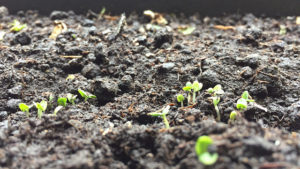Cornucopia’s Take: Mycorrhizal fungi are commonly found in the soil, and they interact with plants to help nutrition, improve the soil, and trap carbon. Our friends at Rodale’s Organic Life offer more information on this symbiotic relationship and to help your garden thrive this season.
Fungi Are The Secret To Perfect Organic Garden Soil
Rodale’s Organic Life
by ROL Staff
 |
Don’t be alarmed! Mycorrhizal fungi are key players in your garden’s ecosystem.
One of the primary principles of organic gardening is that of working with nature, using native resources and natural cycles to increase the abundance and health properties of the plants we grow. Many organic gardeners, however, are not acquainted with the valuable natural ally that embodies that core concept: mycorrhizal fungi.These unique members of the soil community are key players in numerous biological processes: helping plants take up more phosphorus, accumulating carbon in the soil, and improving its clumping ability. Mycorrhizal fungi don’t accomplish these processes on their own; they work in concert with plant roots through the power of symbiosis.
Many species of mycorrhizal fungus spores exist naturally in most soils. If plant roots are present when soil conditions prompt the fungal spore to germinate, the newly developing fungal “roots” (or hyphae) link with the cell walls of the plant roots and grow into them, creating structures that allow for the transfer of nutrients between the two organisms. In this symbiosis, the plant provides the mycorrhizal fungi the sugars they need to keep growing (since fungi can’t photosynthesize to make their own sugars), and the fungi provide the plants with soil nutrients, particularly phosphorus, which their hyphae can extract from the soil more efficiently than the plant roots can.
When a large, vigorous network of mycorrhizal hyphae is associated with a plant’s roots, it exponentially expands the “reach” and surface area of those roots, giving the plant greater access to the nutrients the soil has to offer. This symbiosis is, of course, great for plants, because the extra nutrients can fuel better growth and increase resistance to drought and disease. There are only two instances in which mycorrhizal fungi do not provide benefits to plants: (a) when the soil already has such ideal nutrient and moisture levels that the plants can scavenge enough on their own, or (b) when the plants are brassicas (members of the mustard family), which do not allow the mycorrhizal fungi to colonize their roots.
These mycorrhizal “wrapping and sticking” actions create soil aggregates that form air pockets in the soil.
David D. Douds, Ph.D., a microbiologist with the USDA Agricultural Research Service (ARS), notes that different species of plants have different tendencies toward developing mycorrhizal associations. For example, he has found that leeks greatly benefit from mycorrhizal association in most years, while tomatoes and peppers are more likely to benefit when they are more nutrient-or water-stressed. Brassicas such as turnips and radishes do not form mycorrhizal associations under any conditions.
While these mycorrhizal associations can be excellent for plant growth, they also have positive impacts on the soil. Kris Nichols, Ph.D., a soil microbiologist with the USDA-ARS Northern Plains Research Station, is working to clarify the potential of mycorrhizal fungi to bind soil particles together into stable aggregates (or clumps) and increase amounts of long-lasting carbon in the soil. These benefits are derived in two ways: First, the mycorrhizal hyphae can physically wrap soil particles together, and, second, they secrete a substance, called glomalin, that is a sticky “goo” composed primarily of stable forms of carbon. These mycorrhizal “wrapping and sticking” actions create soil aggregates that form air pockets in the soil (holding air or water between the aggregates, where plant roots need them) and resist erosion, keeping organic matter and nutrients right where you want them (in the garden, rather than running off downstream).
Get the underground army of mycorrhizal fungi to work in the garden by following a few simple management practices:
- If the soil is already high in phosphorus (a simple, inexpensive soil test can answer this), do not fertilize with a phosphorus-rich amendment, because high phosphorus levels inhibit development of associations between plants and mycorrhizal fungi. Manures and manure-based composts can be high in phosphorus, so test these amendments before adding them.
- Minimize digging (especially rototilling), as it can break mycorrhizal hyphae, preventing them from colonizing new plant roots and transporting nutrients.
- Grow a diverse mix of plants in your soil for as much of the year as possible, because mycorrhizae need active plant roots in order to develop.
Some techniques to keep the mix diverse:
- Rotate crops each year (as long as there aren’t too many successive brassicas). Crop rotations are vital to mycorrhizal fungus populations because, in addition to providing a continuous succession of root hosts, different crops also tend to favor different species of mycorrhizal fungi.
- Plant an overwintering cover crop. In addition to adding organic matter and retaining soil nutrients, the cover crop offers host roots for the mycorrhizal fungi to colonize and helps them proliferate in preparation for next spring’s planting. A good mix of crops above ground is the best way to support a mix of beneficial fungi below ground.
- Lighten up a bit on weed control, because, surprising as this may be, weed roots can also be excellent mycorrhizal hosts.
These simple, no-cost steps help keep the soil’s native population of mycorrhizal fungi healthy and diverse, harnessing yet another gift of the natural environment to create a vibrant and abundant garden.

